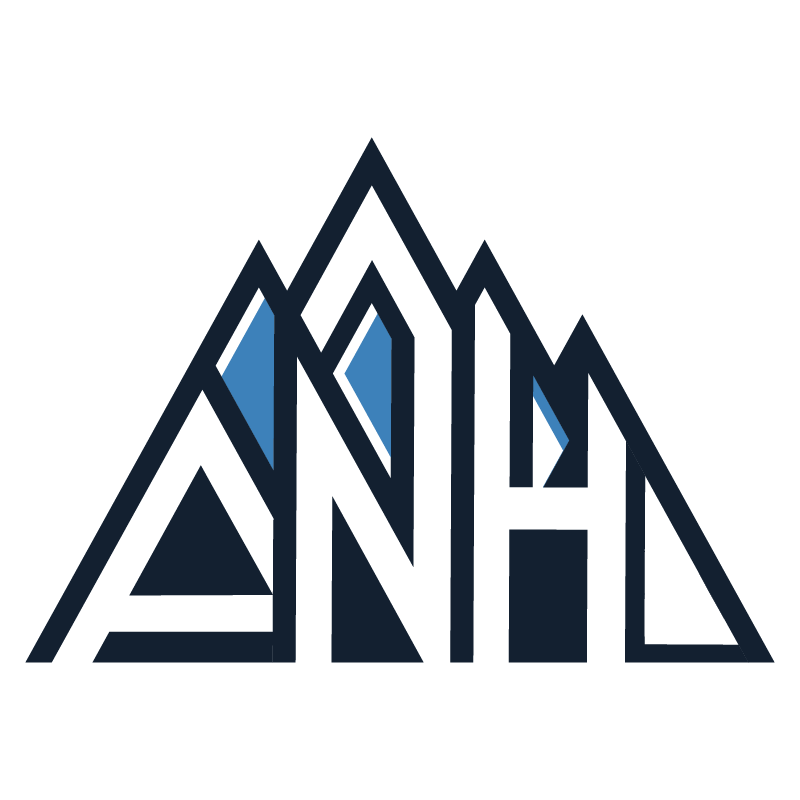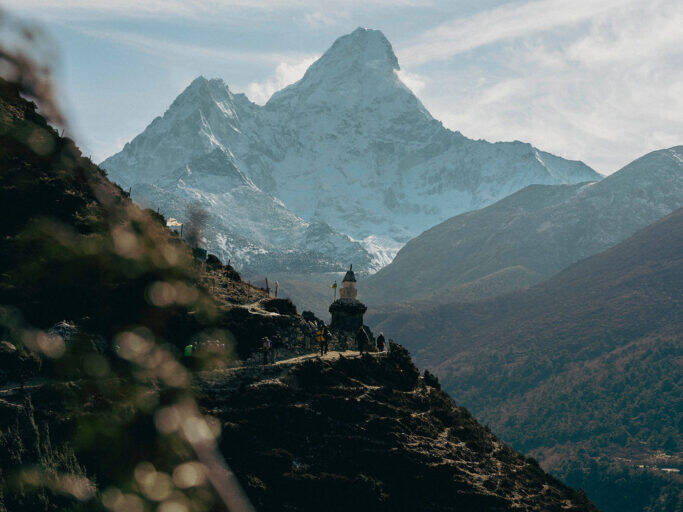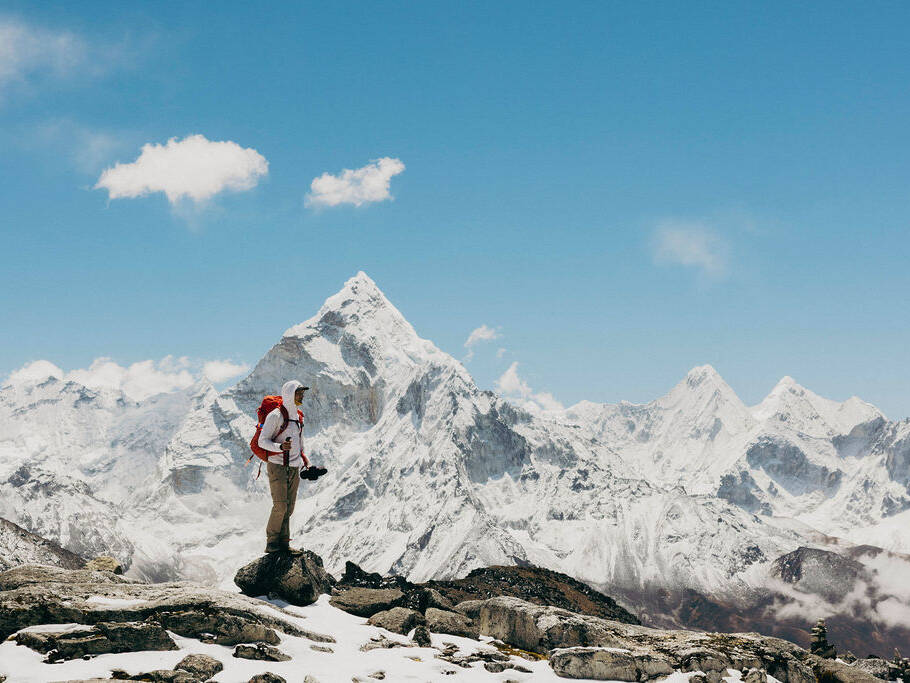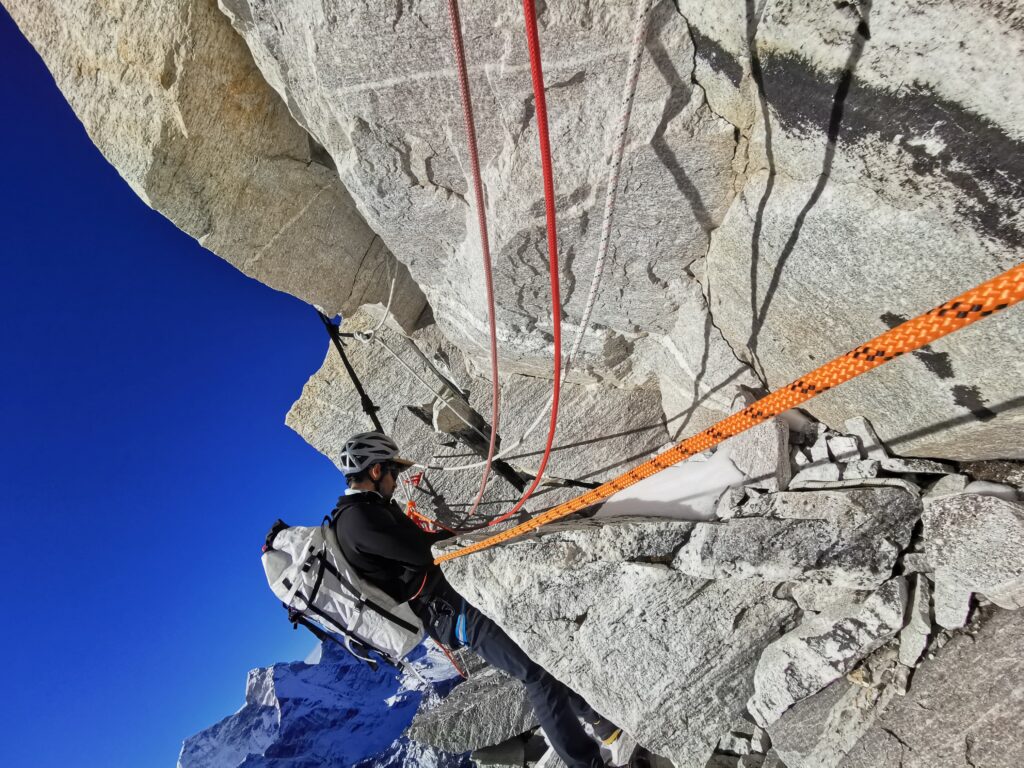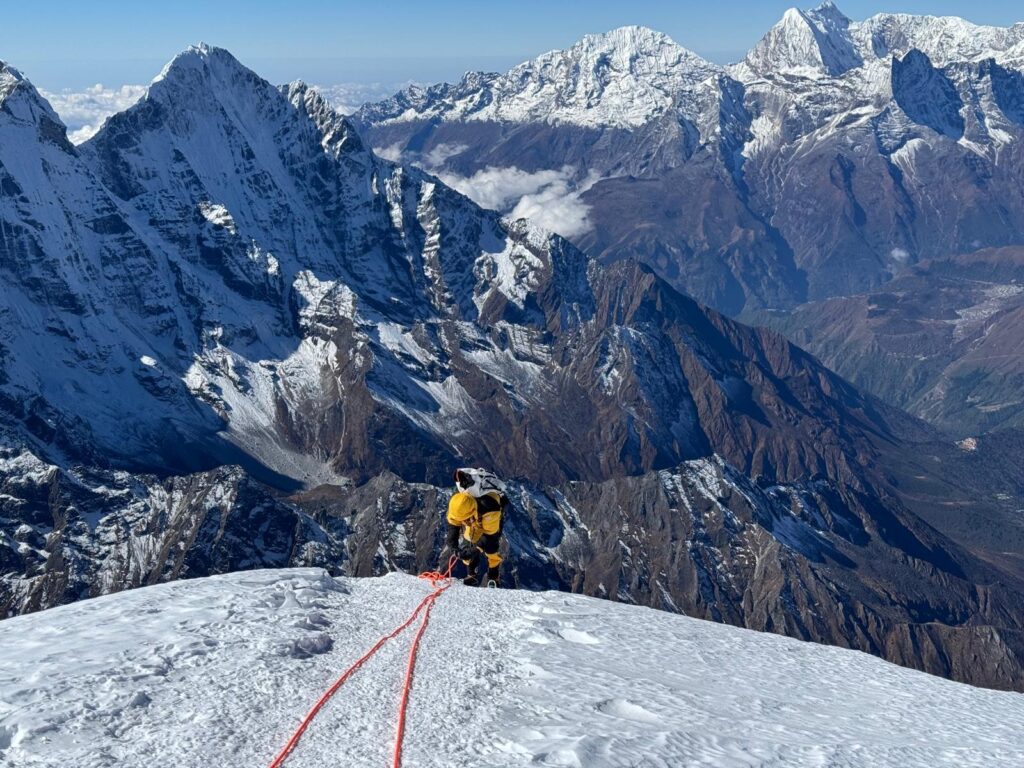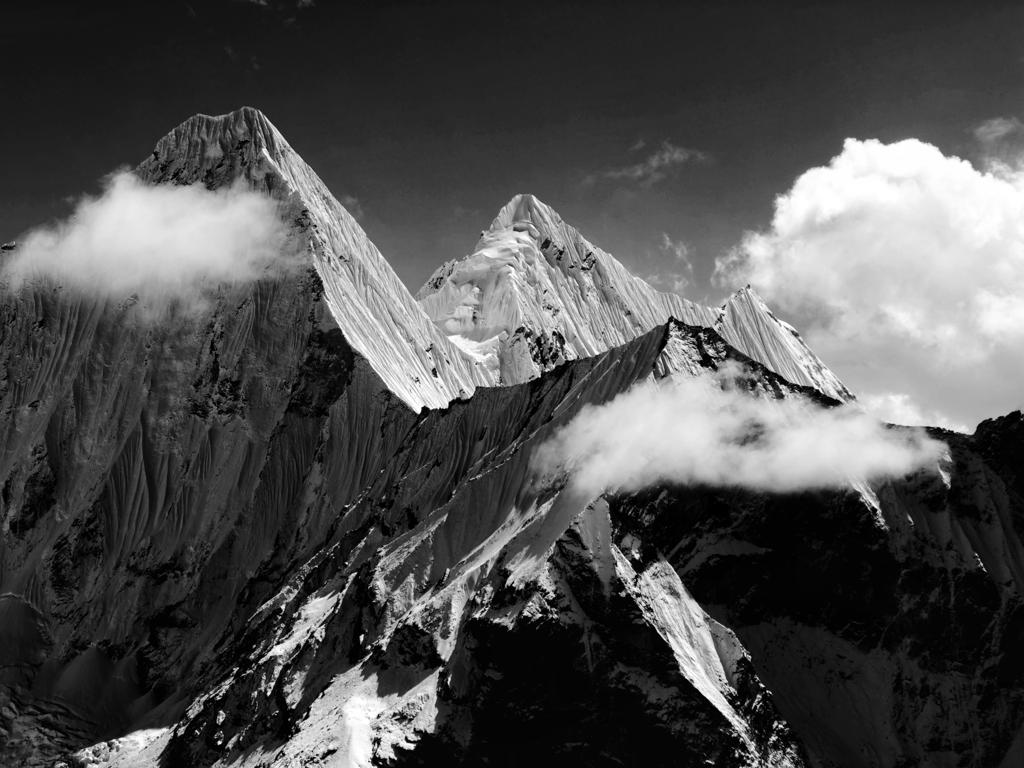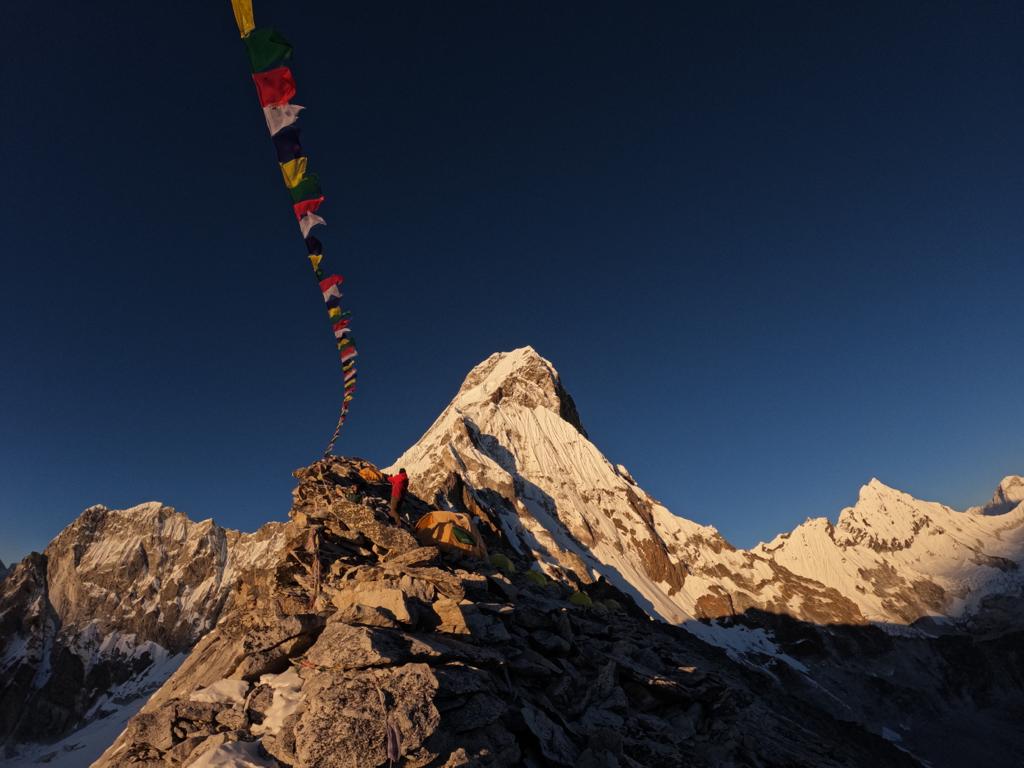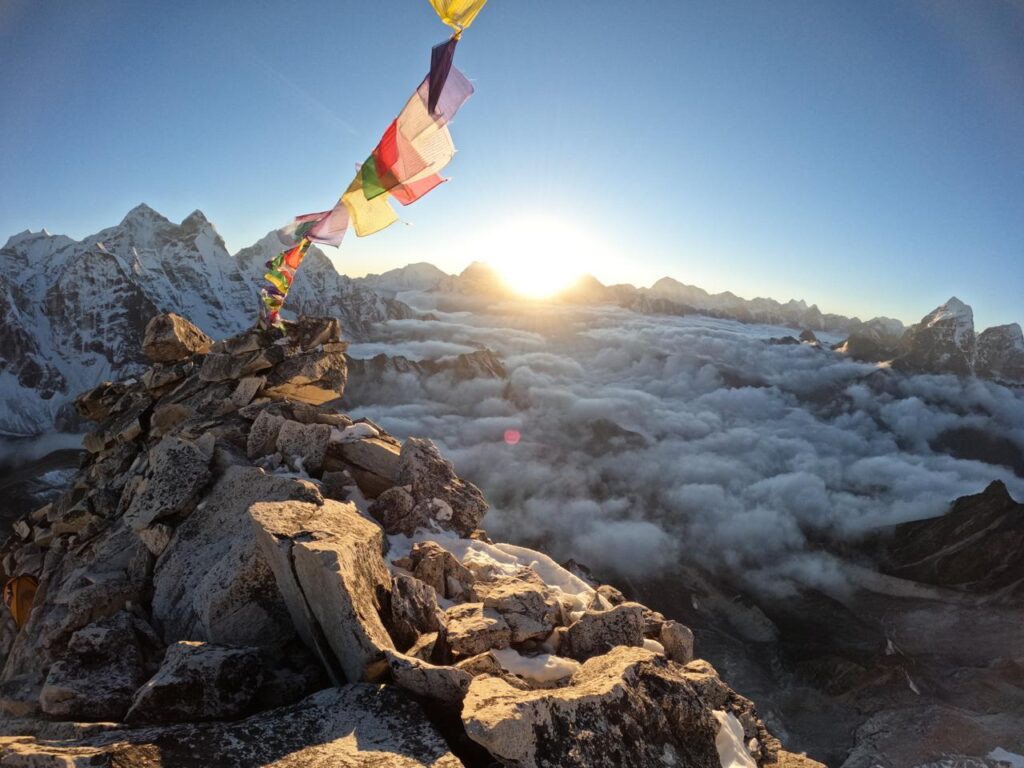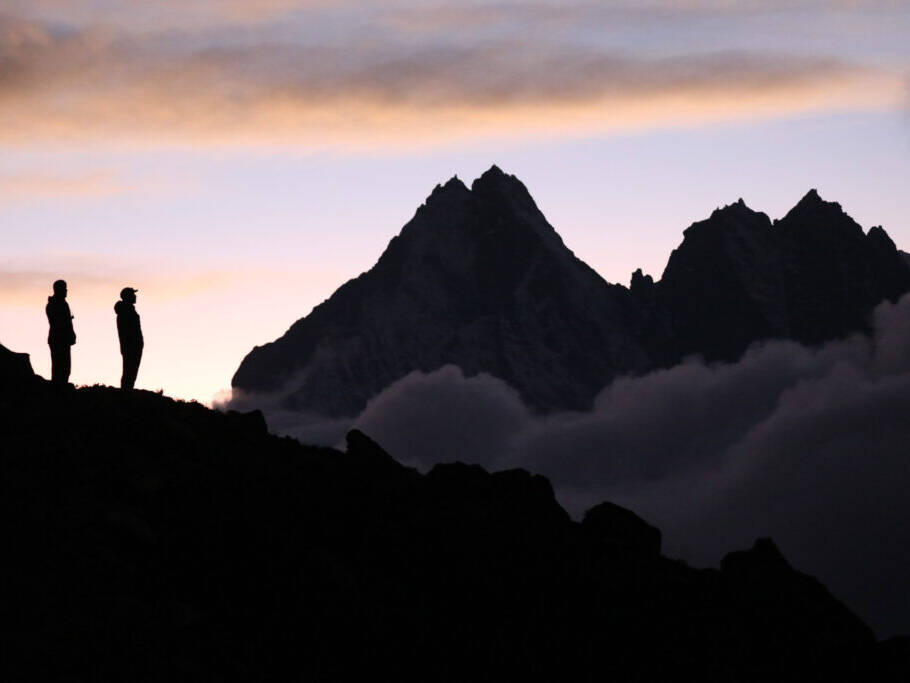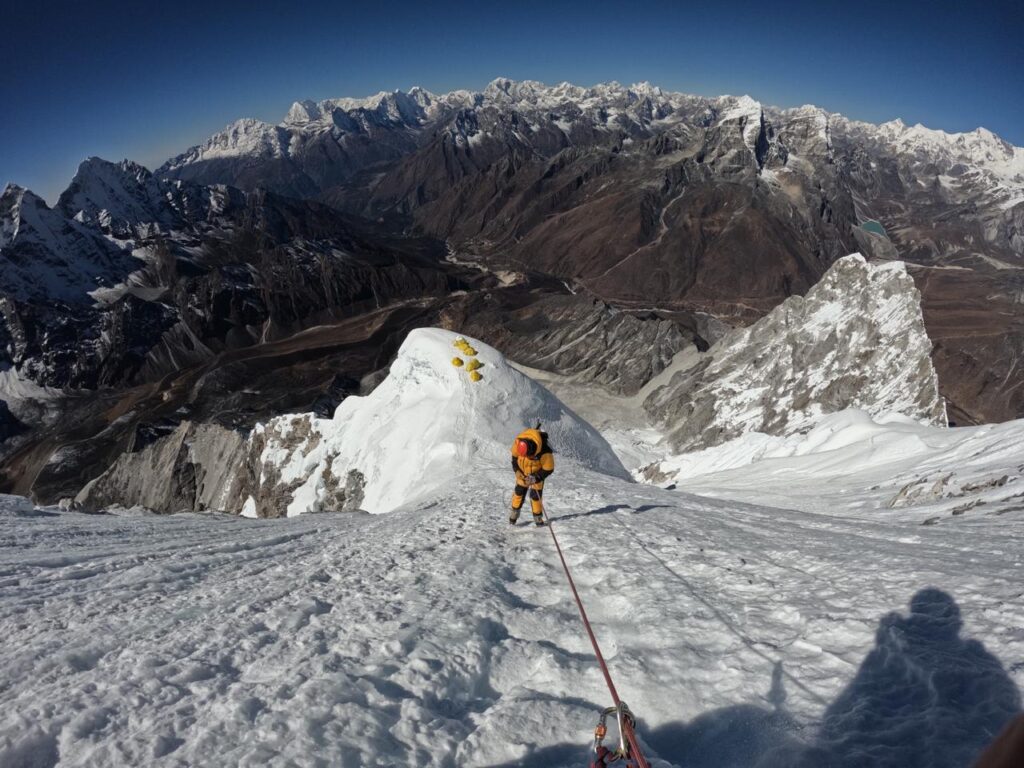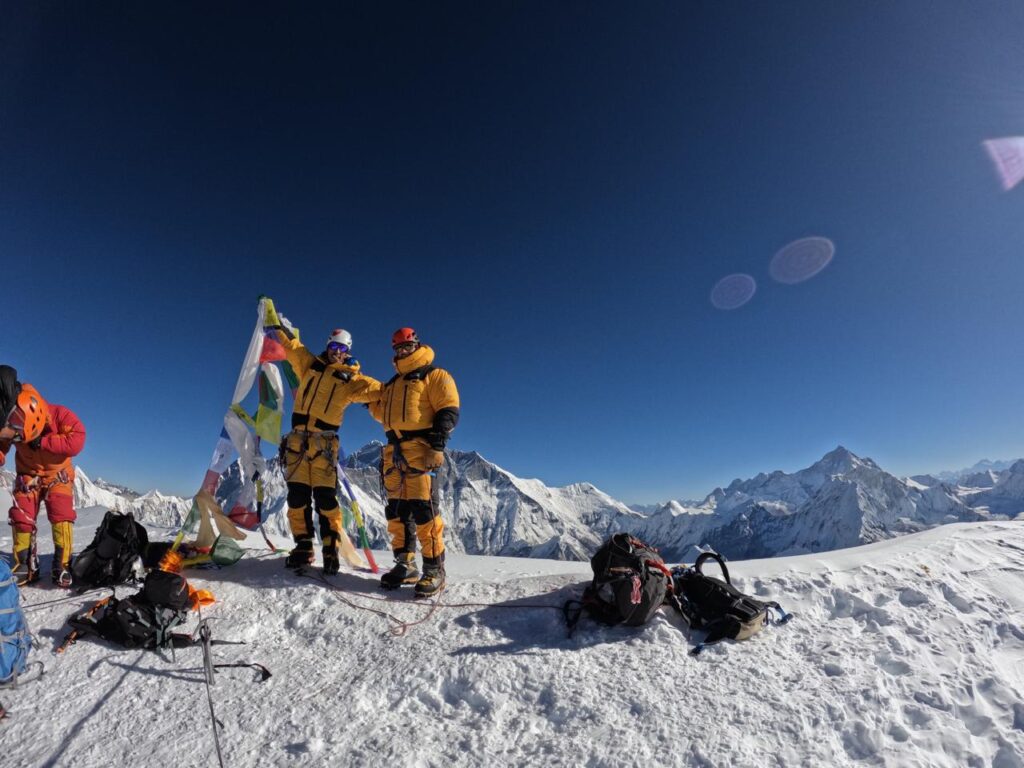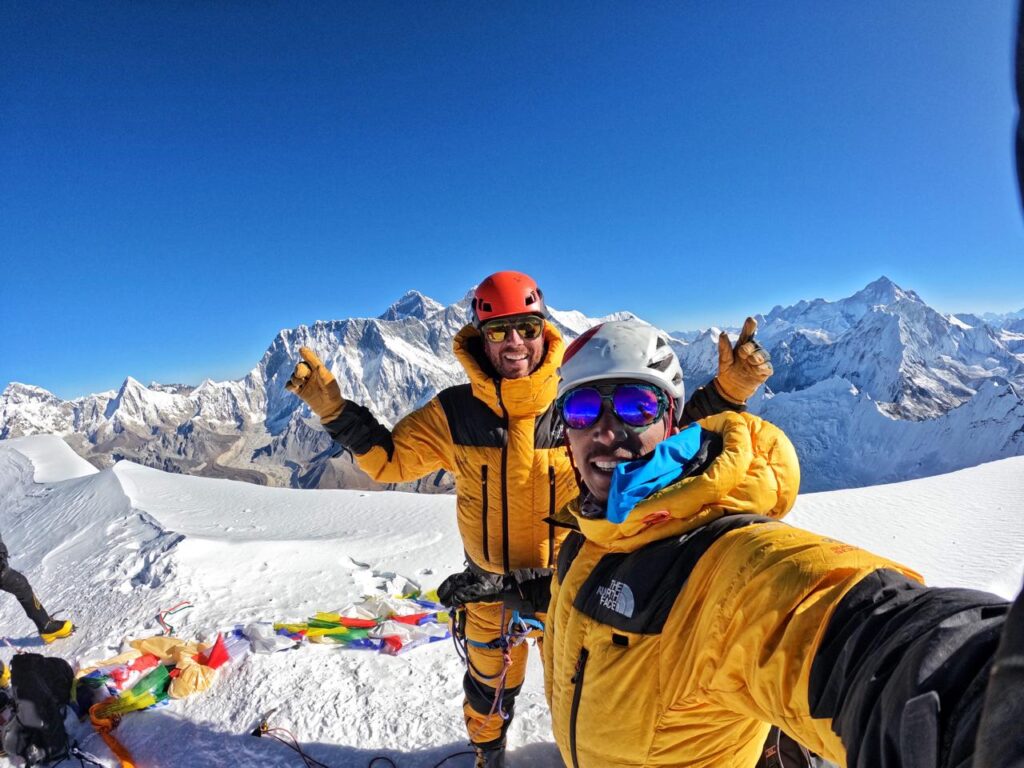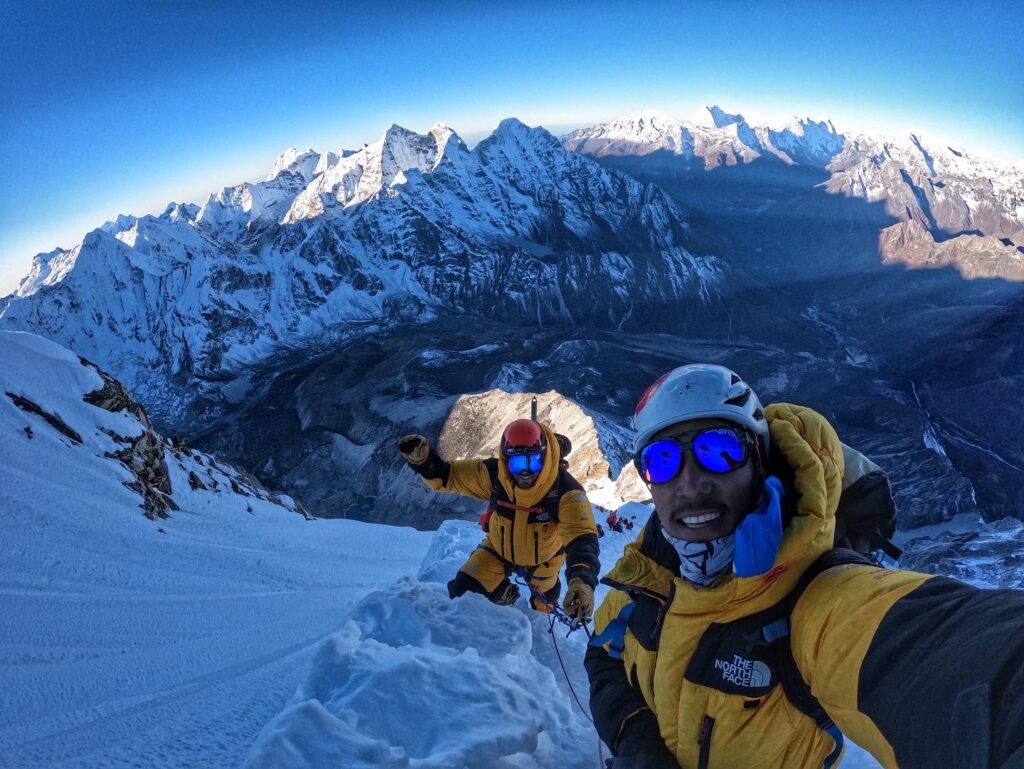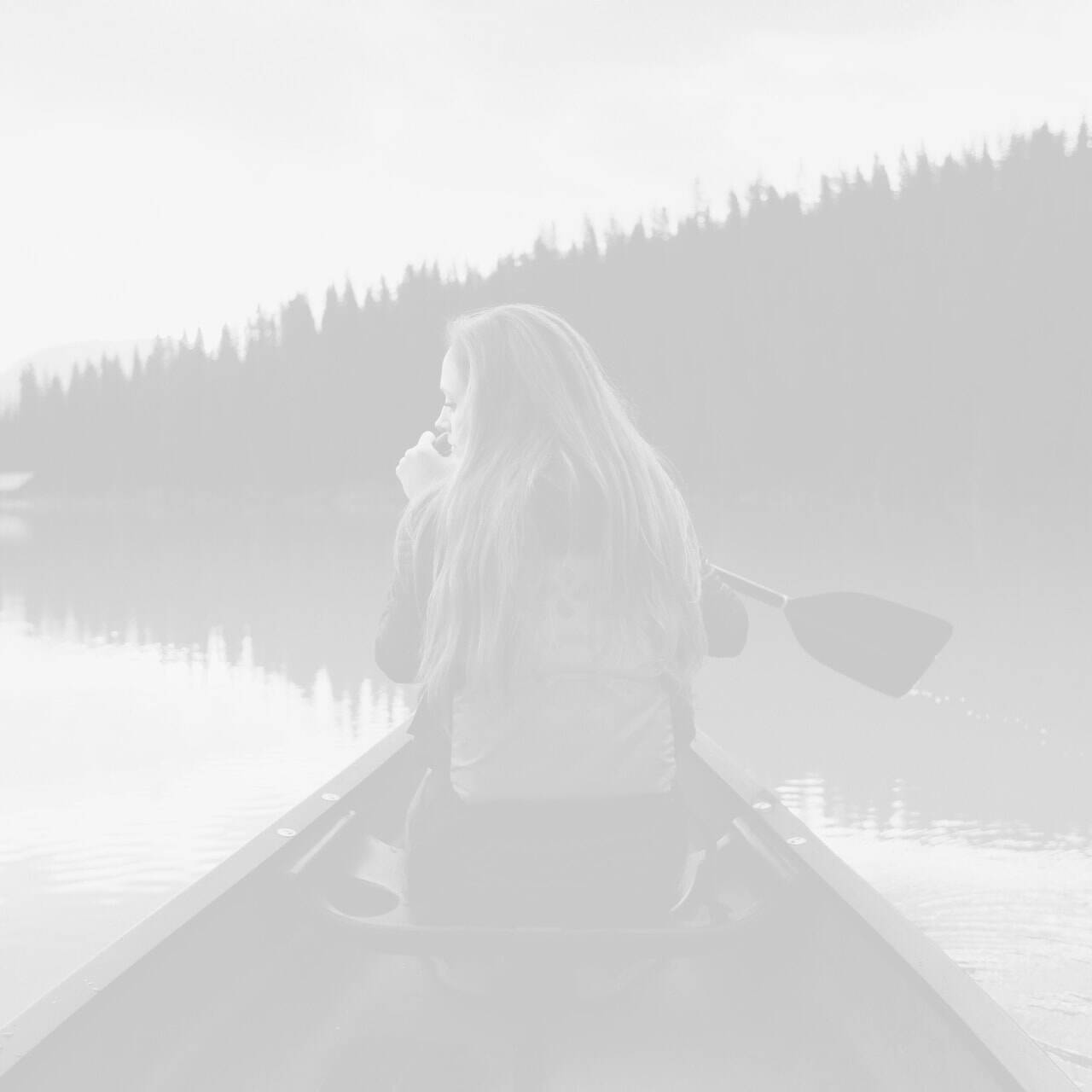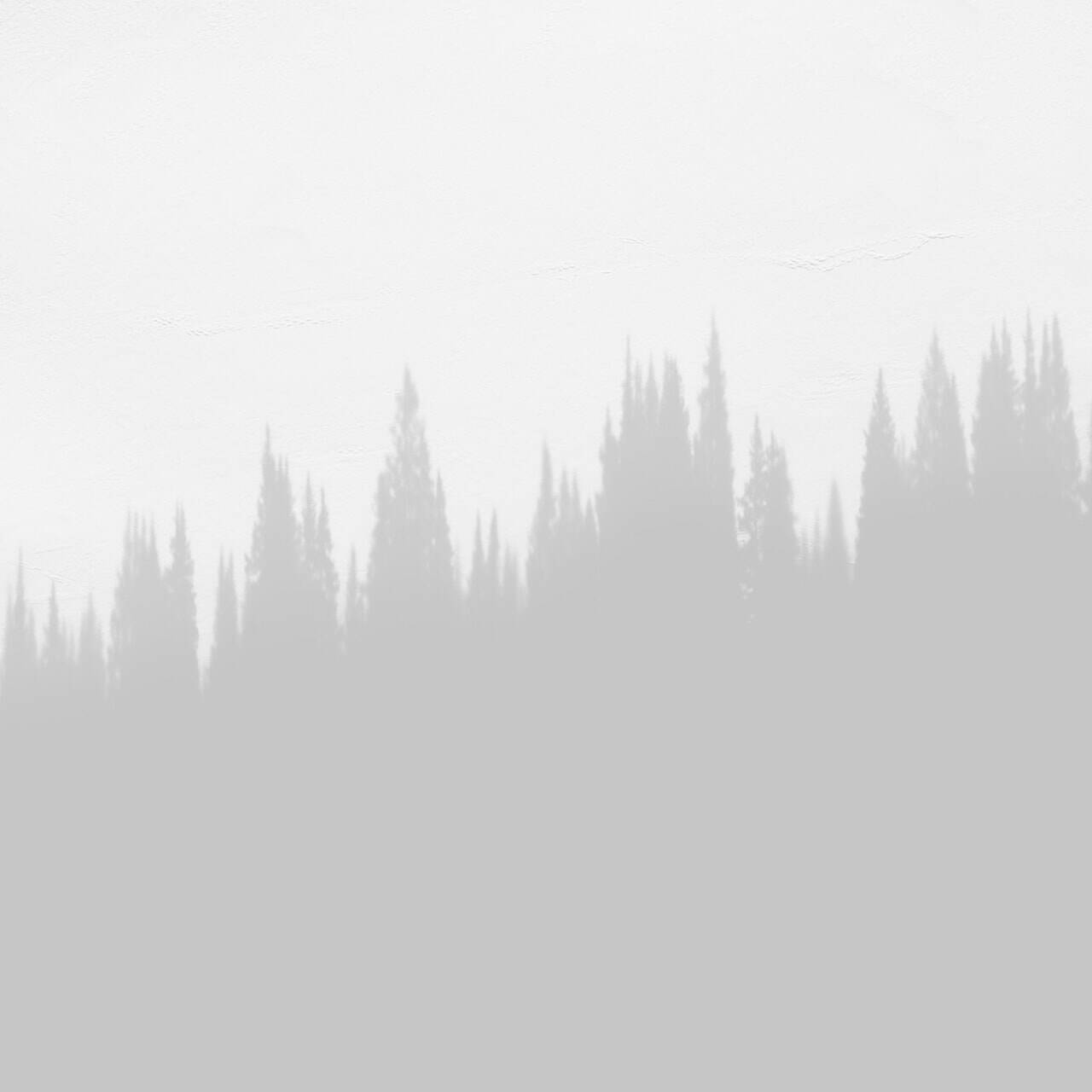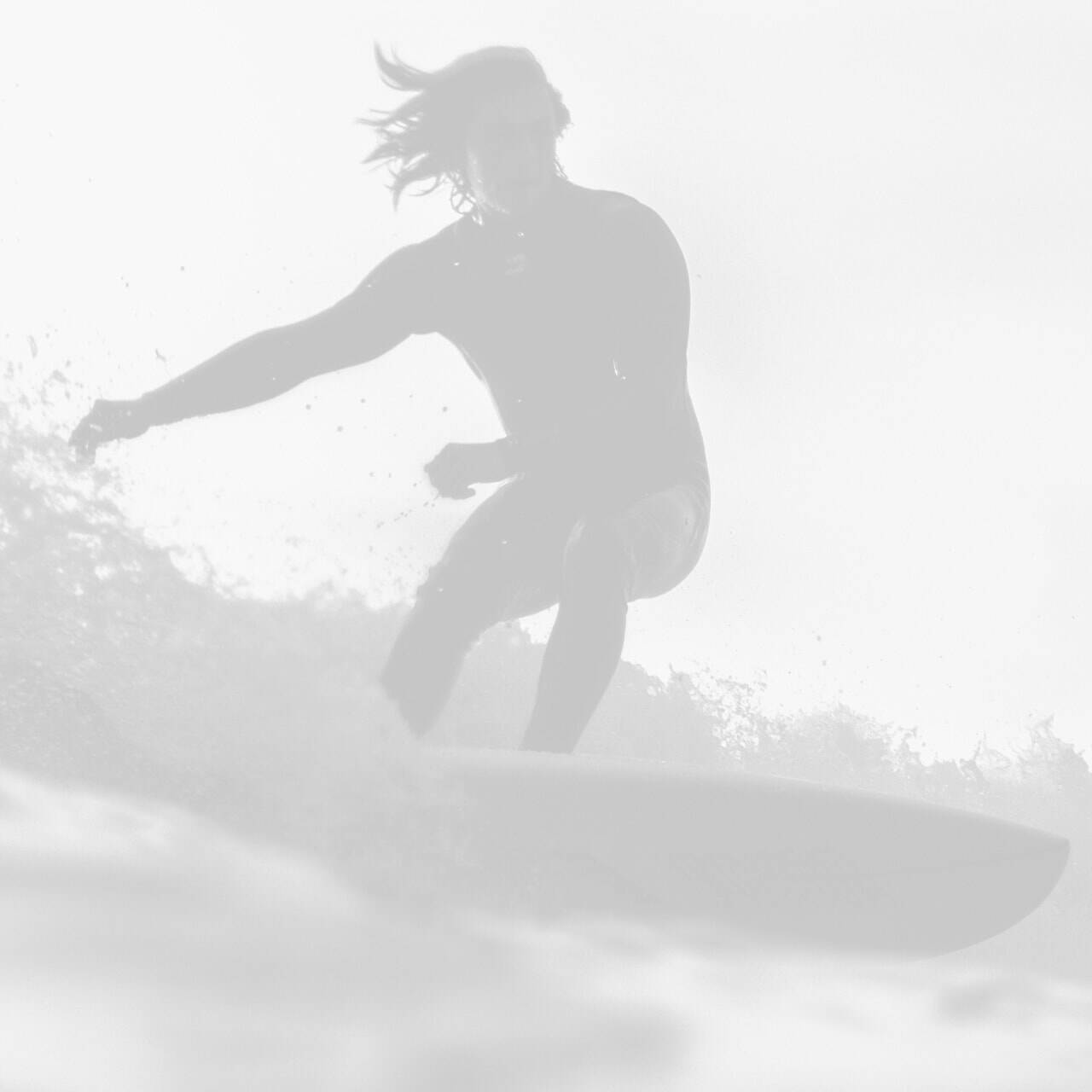Mera peak Climbing
Mera Peak, 6476m, is the highest permitted trekking peak in Nepal as per NMA(Nepal Mountaineering Association) but technically an easy climb compared to other 6000m trekking peaks in Nepal. Therefore, an excellent peak for those looking for thier first climbing experience in the Himalaya of Nepal. The 6476m altitude do cover up for the technical differences hence good preparations, physically and mentally is required. The other main reason people opt to climb Mera Peak is the magnificent summit view of the over-8000-meter-mountains such as Mt. Everest, 8848m, Mt. Lhotse, 8516m, Mt. Cho Oyu, 8201m, Mt. Makalu, 8463m, and Mt. Kanchenjunga, 8586m.
Mera Peak, 6476m, is the highest permitted trekking peak in Nepal as per NMA(Nepal Mountaineering Association) but technically an easy climb compared to other 6000m trekking peaks in Nepal. Therefore, an excellent peak for those looking for thier first climbing experience in the Himalaya of Nepal. The 6476m altitude do cover up for the technical differences hence good preparations, physically and mentally is required. The other main reason people opt to climb Mera Peak is the magnificent summit view of the over-8000-meter-mountains such as Mt. Everest, 8848m, Mt. Lhotse, 8516m, Mt. Cho Oyu, 8201m, Mt. Makalu, 8463m, and Mt. Kanchenjunga, 8586m.
Mera Peak Climbing trip starts with a flight from Kathmandu to Lukla. The trek leads through the incredibly remote and beautiful Hinku Valley. This unspoiled area of the Everest region boasts of beautiful green terraced fields, dense forest, rushing streams, swinging bridges, and yak pastures with a backdrop of the highest mountains in the world. Sherpa guesthouses, high in the summer pastures, are a welcome place for weary trekkers.
Previous climbing experience on snow and ice would be a great advantage, additionaly our well-experienced Sherpa climbing guides will organize a training session on the climbing gear and necessary skills required for the climb.This is a straightforward climb for which acclimatization is crucial. As you trek higher into this remote valley, following the river to the glaciers, your body is gradually becoming acclimatized for the climb. Khare village 4,950m is the last village on the Mera Peak trail where we will have Tea Houses. We have a mandatory acclamatization day, basic climbing clinic program and checking our gears and equipments before we move to mountain. We will set High Camp 5780m before attempting for the final summit push.
Our climbing guides are dedicated mountaineers and license-holders who always put your safety first. They use harness and ropes below the every peak whether for crevasse danger or steep slopes. Our Sherpa guides are there to fix the rope as well as teach climbers how to fix the rope or set up a belay for glacier travel.
Safety for Mera Peak Climb:
When travelling in remote mountain regions, uncertainties such as weather, health problems and natural disasters require a certain amount of flexibility. While our goal is to follow the itinerary, that is not our first priority; your safety is always our first priority. Expeditions high mountain. request your cooperation to accept the decisions and advice of our trusted and experienced guides if they deem it necessary to change or cancel any part of the itinerary due to safety concerns.
We should also plan for few extra days as bad weather may affect the designed schedule. This doesnt guarantee the successful ascent but often avoids the disappointment of a cloudy summit day.
Travel Insurance:
You will need special travel insurance for participation in hazardous activities. We recommend a complete travel insurance policy that covers cancellation, lost baggage, theft, injury, liability, medical treatment, death and expenses. Make sure the insurance covers all the activities that you will be undertaking during your stay in Nepal including trekking and climbing.
Remark: – Please note that cloud and turbulent weather is a regular phenomenon in the Himalayan range. It is thus possible that domestic flights from Kathmandu to/from Lukla may be delayed for a few hours or even canceled for a day or more. Fortunately, this does not happen frequently during the high seasons of March to May or September to November: but you need to plan for this possibility.
As a safeguard, we recommend that you add on a couple of extra days after your trek before you fly from Kathmandu to your onward destination.
Detailed Itinerary
01
Arrival in Kathmandu airport. Overnight at hotel.
02
Fly from Kathmandu to Lukla 2,800m. and trek to Chutanga: 3,100 m 3-4 hrs.
03
Chutanga to Kharka Teng. 3,500m 3 hrs.
04
Kharka Teng to Thuli Kharka (4,200m by chattra la pass 4,610m-6 hrs.
05
Thuli Kharka to Kothe( 3880m) 6 hrs.
06
Kothe to Tangnang (4,250m) 3-4 hrs.
07
Tangnang rest day.
08
tangnag to khare 4950m 3-4 hrs.
09
Khare ( acclimatize and training day.
10
Khare to Mera High Camp 5800m. 6-7 hrs.
11
High camp- summit 6,476m back to khare 8-9 hrs.
12
Khare to Kothe 6-7 hrs.
13
Kothe to Chettra /thuli kharka 6-7 hrs.
14
Chattra /thuli kharka to lukla 6-7 hrs
15
Fly lukla to Kathmandu.
16
Extra day if incase weather bad.
17
Final departure.
Included in Your Trek Package:
- Transfer from Airport – Hotel – Airport: Car, Van, Hi-ace or Coaster in a private vehicle
- Accommodation in Kathmandu: 4 nights on Twin-share Bed and Breakfast Basis
- Accommodation during Trek: Local lodges with comfortable foam mattress and pillows
- Meals on full board basis (Breakfast, Lunch, and Dinner) during the trek
- Accommodation during Camping: Meals during Camping (1 night at Base Camp and 1 night at High Camp)
- English-speaking experienced and certified Sherpa Guide (Govt. Trained/License Holder)
- All Camping Equipment required during the trek: Sleeping tents, mattresses, kitchen tent, kitchen equipment
- Climbing equipment: Climbing rope, Ice screws, Snow bar
- Trekking cook, kitchen staff, Trek Sherpa, and other support staff during camping days
- One Sherpa guide-assistant if group size exceeds 4 trekkers
- Porters: One porter for every two trekkers on all climbing trips
- Trek Staff costs including their salary, insurance, equipment, food, and accommodation
- Personal insurance for Nepalese staff
- Energy supplies (Snickers, Mars, Bounty) and fresh/canned fruits on the trek
- First aid medical kit
- Mera Peak Climbing Permit
- Sagarmatha National Park Fee, TIMS permits & all required official documentation
- All government and local taxes
- Garbage management fee
- Mera Peak Climbing certificates issued by the respective body of Nepal Government
- Personal travel and medical insurance (mandatory)
- Nepal Entry Visa fee
- Lunches and dinners in Kathmandu
- Beverages such as soft drinks, mineral water, boiled water, and beer
- Tips for guide, porters, and driver (customary)
- Any personal expenses not mentioned in the “Cost Includes” section
- Additional nights’ accommodation in Kathmandu due to early return from trek (for any reason) beyond the planned itinerary
Packing List
Rule of thumb: Carry spares of all survival-critical equipment, ensure all gear is UIAA or CE tested,
and practice using it with gloves in adverse conditions. Your life may depend on it.
Essential Personal Climbing Gear
- Climbing Helmet – lightweight, essential for rock and icefall protection
- Alpine Climbing Harness – light, simple, glove-friendly, with secure locking features
- Crampons – steel, anti-balling, precise fit for boots
- Ice Axe – versatile, T-rated, lightweight
- Ascender (Jumar) – glove-compatible; practice beforehand
- Multi-LED Headlamp with spare batteries
- Carabiners – 2 locking (large/small) + 4 regular
- Rappel Device (Figure 8, ATC, etc.); know Munter Hitch backup
- Trekking Poles – adjustable, reliable locking mechanism
- Slings (1 × 3m, 3 × 2m)
- Prusik Loops – useful backup tools
- Masks, hoses, and regulators – high quality
- Altimeter or GPS watch with long battery life
Clothing & Layering
Recommended base layers: Merino wool or Merino-synthetic blends (Icebreaker, Odlo).
Upper Body
- 1–2 Merino short-sleeve shirts (150–200 weight)
- 2 Merino long-sleeve shirts (light & thick)
- Fleece pullover + fleece jacket
- Waterproof Gore-Tex hardshell jacket with helmet-compatible hood
- Lightweight down jacket for camp and rest stops
- Expedition-grade down jacket (or down suit) for summit
Hands
- Liner gloves
- Gore-Tex over-mitts with very warm down mitts (plus spares)
Head
- Warm hat (wool/synthetic) covering ears
- Balaclava or face mask
- Buff/neck scarf
- Sun cap or brimmed hat
- Glacier sunglasses with side shields (2 pairs)
- Ski goggles (light & dark lens, optional)
Lower Body
- Merino underwear (briefs)
- Walking trousers & optional shorts
- Thermal Merino bottoms (2 light, 1 heavy)
- Fleece/mid-layer trousers
- Gore-Tex overtrousers (full side zips)
- Goose-down trousers or down suit
Feet
- Expedition alpine boots (La Sportiva Olympus Mons or equivalent)
- Sturdy trekking boots (Gore-Tex, good ankle support)
- Camp shoes/sandals or trainers
- Wool/poly socks (2 pairs), liner socks (2 pairs)
- Optional vapor barrier liners
- Light socks for Kathmandu/town
Travel & Sleeping Gear
- Medium rucksack (35–50L) – cabin carry
- Large durable duffle bag – for porters/pack animals
- Small padlocks for duffle security
- High-altitude down sleeping bag (–35°C)
- Base camp sleeping bag (–15°C to –20°C)
- Closed-cell foam mats (≥3, Thermarest preferred)
Medical & Hygiene
- Personal hygiene kit (toothbrush, paste, fast-dry towel, sanitizer)
- Sun cream (SPF 30+), lip balm, after-sun lotion
- Anti-mosquito cream
- Personal first aid kit with bandages, blister kit, meds
- Essential prescriptions – inform leader
- Altitude meds: Diamox, antibiotics (stomach & chest), Imodium, Ibuprofen/Aspirin
- Water purification tablets/filter/UV sterilizer
- Spare glasses/contact lenses
Personal Food
- 5 dehydrated/freeze-dried dinners for summit attempt
- Personal snacks/energy food (bars, chocolate, nuts, etc.)
- Optional specialty foods (import if required)
Miscellaneous Practical Items
- Repair tape & sewing kit
- Lighter, storm matches
- Compass or GPS
- Solar charger, alarm clock
- Digital camera with spares
- Stuff sacks, waterproof bags
- 3 × 1L Nalgene bottles (1 for pee)
- Plastic cup, spoon, folding knife
- Binoculars (optional)
- Waterproof rubbish sacks
- Passport, copies, photos, flight docs, insurance proof
- Cash (USD/EUR small denominations), cards, travel checks
Altitude Hazards & Complications
Mountaineers face risks from low oxygen (AMS, HACE, HAPE), frostbite, hypothermia, thrombosis, embolisms,
UV overexposure, and hazards like avalanches or rockfall. Acclimatization, rapid descent when symptoms appear,
and preparation are essential to survival.
FAQ
From our past clients on similar treks.
It’s considered an intermediate trek. A good fitness level and mental preparation are key, but with a proper itinerary and support, most people can complete it.
Everest Base Camp sits at 5,364 meters (17,598 feet).
Our itinerary is designed to allow proper acclimatization, and our guides are trained to monitor for symptoms. In emergencies, we will arrange safe descent and medical support.
Yes, comprehensive travel insurance with emergency evacuation coverage is mandatory.
We welcome solo trekkers and will match you with a group if you prefer shared experience.
Spring (March–May) and Autumn (September–November) are ideal for weather, visibility, and trail conditions.
Yes. We handle all required trekking permits for Sagarmatha National Park and Khumbu Rural Municipality.
“ I have been on many workshops with great photographers but non has ever come close to being this great. Selena took into consideration the clouds, the weather, the right times of the day and hit a home run every time. Amazing! ”
Nathan Watkins
LONDON
“ I signed up for my first workshop with Selena with a love of photography, but as a novice of real camera equipment and no experience. Somehow I convinced Selena to take me on, and he promised to help me learn to use the gear. ”
Elise Brooks
BERLIN
“ Selena private workshops were in all respects a highly rewarding experience. Her photographic expertise as well as his extensive knowledge of the street area proved tremendous assets on both the sunset and sunrise street workshops. ”
Emerson Taylor
AMSTERDAM
Ready to begin your journey?
Let’s talk about your goals, your questions, and the trek that might change everything.
